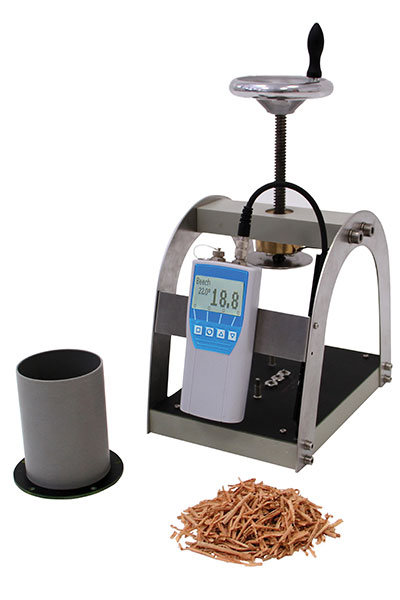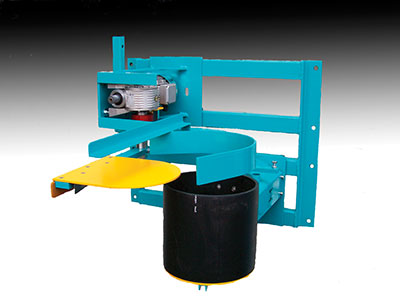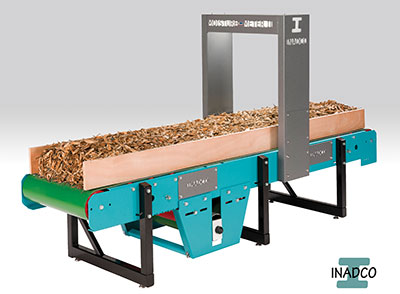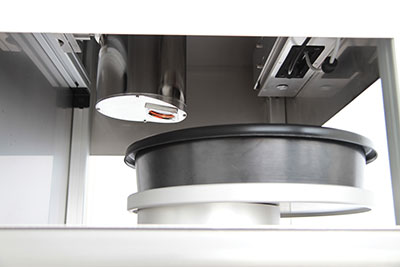
Moisture measurement
December 5, 2014
By Treena Hein
As the value of raw feedstocks such as sawdust and finished products such as pellets continues to increase, the importance of streamlining biomass processing has never been greater.
As the value of raw feedstocks such as sawdust and finished products such as pellets continues to increase, the importance of streamlining biomass processing has never been greater. Moisture percentage is a huge factor in determining the energy content for a given volume of biomass materials. Knowing precise moisture content is needed at the front end to gauge fair value for raw feedstock, and at various processing steps so that processing energy (heat and electricity) is not being wasted.
 |
|
| The BLH Moisture Meter from ELECTROMATIC is suitable for wood shavings.
|
To help you determine the value of what’s coming into your plant, increase the quality of your products or improve/accelerate processing activities, we’ve gathered up the latest on the newest moisture meter options. Moisture meter tech for biomass has come a long way over the last few years in terms of reliability, accuracy and speed. It’s been a complex sector for technology developers, as raw materials can be mixed (bark and sawdust, for example), is often highly compressible, and can possess a highly uneven distribution of moisture.
There are two choices in measuring the moisture content of any biomass material or product: analysing samples or analysing materials continuously as they move along an infeed or processing step. A sampling method that’s still commonly used involves weighing some raw material samples from the truck, drying them over 24 to 48 hours, and then weighing again. While it’s a highly accurate method, there is obviously a big lag time in obtaining results, and those results can only truly be guaranteed for those samples and may not be representative of the entire volume. A quicker and more accurate method for the entire batch is preferable.
“Biomass prices go up and up, and because of that the quality goes down, at least in Europe,” says Theo Coolen. “Mixes become more and more inhomogeneous, and moisture content is changing from one moment to the other. So sampling and bringing that sample to a laboratory is not fast enough to use the data for process control. The need for online measurement goes up.” Coolen is the managing director at Inadco, a Netherlands-based company that offers moisture sensors for a variety of industries, from potting soil and peat to brick manufacturing, biomass and food. The company is currently looking for distributors in order to enter the North American biomass market. Inadco has developed both an instrument for quick analysis of samples (the Moisturemeter I, which can give a result once every 60 seconds), and a continuous-measurement instrument (the Moisturemeter II). They are both designed for peat and bigger biomass material such woodchips and bark.
 |
|
| Here is the MoistTech IR3000 monitoring the moisture of incoming raw material into plant operations. With hundreds of measurements per second, it monitors material with precise accuracy.
|
To get a high-quality measurement result through sampling, Inadco stresses that enough samples, and materials in the samples of a representative nature of all of the materials in the batch are needed. The measurement volume must be much bigger than the biggest piece of material in the batch, and the moisture-measuring instrument must have very good bulk density compensation to address the changing compression or flow-properties of the material.
“That was the reason why we developed our own moisture measuring system, the brand-new Moisturemeter II,” explains Coolen. “It needed to have a huge measuring volume, much bigger than any system available on the market.” The need for equipment that could measure bigger particle sizes with more variety in it was rising in Europe, with more and more forest residues being used for feeding combined heat and power plants. “The compression of the product is also a very important factor for the end result of the measurement,” Coolen adds. (Their moisture meter equipment is used in combination with their long-existing densimeter, which measures compression.)
Brett Linzer agrees that consistency, size and bulk density of wood chips are the biggest challenges in accurately measuring wood chip moisture content. Linzer represents ELECTROMATIC Equipment, which makes Checkline moisture meters. “Two of these challenges are handled by categorizing wood chips in sizes and using certain procedures to fill measuring chambers to compensate for bulk density,” he says. “In addition, our calibration curves are weight-based to achieve the most accurate results.”
To work around the other challenge – wood chip consistency – the company has developed “moisture curves” based on type of material. “Our entire product range can be adjusted to meet the customers’ specifications,” Linzer explains. However, he notes that whenever there is material polluted with other materials, the challenge gets bigger. “If the consistency of this pollution stays the same, the internal moisture can be adapted,” he explains. “Often this is not the case and then it becomes a very difficult. Overall, we keep looking and expanding our product lines to cover as many applications as possible. We use several different types of measurement methods, which all have their advantages and disadvantages depending on the usage. The trick is to find the best solution for that application.”
 |
|
 |
|
| Inadco has developed both an instrument for quick analysis of samples (the Moisturemeter I, which can give a result once every 60 seconds), and a continuous-measurement instrument (the Moisturemeter II). They are both designed for peat and bigger biomass material such woodchips and bark.
|
Checkline offers a wide range of hand-held, portable and online instruments with instantaneous readings. Their BM series is suitable for wood chips, saw dust, pellets, bark, wood shavings and more. The BLL device is suited for wood chip piles, the BP1 for pellets, the BLH for wood shavings and the BLW for round timber and split logs. In terms of fixed installation, Checkline’s BLO System can be installed in various configurations, with the sensors chosen based on the material (wood chips or shavings for example). Linzer says the accuracy that can be achieved in terms of moisture content readings depends on the accuracy of the calibration curve for the material and the consistency of the material that runs over the sensors.
Checkline also recently launched the BMA, a tool specifically for companies that buy large quantities of wood chips and pay per ton. The BMA is an automated meter where a sample bin is filled and placed into the machine by the operator. The system weighs the sample and then starts compressing it to a specific pressure at which the measurement is taken and displayed. As an option, it can also calculate the ATRO ton weight (dry weight per tonne). “Currently, this is the most accurate wood chip moisture content meter available,” Linzer says. “We also offer a wide range of online sensors that can be implemented in augers or on conveyor belts. These systems require support to set them up with the correct moisture curve and sensor type, but once properly configured, they are the most economic and accurate solution around.”
Spektron Biomass also offers a moisture content meter that delivers instant results. The near-infrared (NIR) “Spektron” can be used to measure moisture in different kinds of biomass materials, provided samples of the materials (feedstock or finished products) are included in the calibration of the instrument. Calibration should be done every 6 to 12 months, or as changes occur with materials or the process environment. “The Spektron can also be installed directly above a conveyor belt to analyze moisture in real time,” says company representative Mari-Ann Akerjord. “This makes it possible to measure a complete container of biomass material in real time. The accuracy of single measurements is the same, but the average of a complete container will, of course, be better with an online solution. Which solution is best depends on how the processes are organized.”
The company also offers software, and can integrate the Spektron to any plant’s computer so that results are integrated automatically. “The system includes online production support and reporting from single sample, up to plant and enterprise level,” says Akerjord. “We work in close co-ordination with the production managers to give the best possible and useful results to optimize the processes.” If installed in multiple plants, the devices are connected to a common server and the calibration is upgraded remotely with inputs from all other units, with all units sharing the same calibration.
The IR-3000 is MoistTech’s newest online moisture-measuring instrument, developed for instant, non-contact analysis in the harshest environments. Company President Adrian Fordham says it is insensitive to material variations such as particle size, material height and colour, and provides continuous, reliable readings without drift or frequent re-calibration. “With hundreds of measurements per second, plant controllers can monitor incoming material with precise accuracy,” Fordham notes.
 |
|
| The Spektron from Spektron Biomass can be used to measure moisture in different kind of biomass materials, provided samples of the materials are included in the calibration of the instrument.
|
Drying Technology’s Delta T MC Sensing and Control System solves the three main problems with moisture meter systems by including an exclusive “inside-the-dryer” sensor that detects evaporative load changes before they exit the dryer, and makes heat adjustments. The system measures the amount of additional water to be evaporated, and uses an exclusive method for re-calculating the process variable setpoint needed to maintain the target moisture content.
“When these three solutions are combined…the product moisture content variation exiting the dryer is reduced 30 per cent for a single dryer and approaches 51 per cent when two dryers are in series, or two zones of a multi-zoned dryer are controlled individually,” says Drying Technology President John Robinson. “The Delta T eliminates the need to pre-mix incoming biomass, and then makes moisture content determination of the mixture for use in setting the dryer operating conditions.” Robinson says this system also eliminates over-drying and having to add moisture back in (to achieve the desired moisture content for pelletizing for example), and allows production to be increased by adding more feed to bring the hot air temperature back to the maximum limit.
Print this page